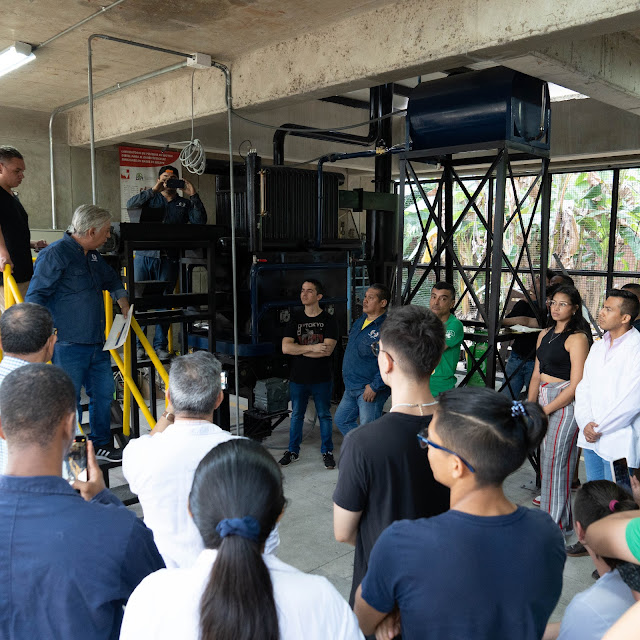Researchers from the Universidad del Valle (Univalle), together with PVSA SAS and Cenicaña, carried out the design, construction, assembly and commissioning of a new incinerator prototype. The prototype will contribute to the evaluation of the combustion of sugar cane cutting residues and is located in the boiler laboratory of the School of Mechanical Engineering.
In the Valle del Cauca region, there are around 241,205 hectares of sugar cane planted, according to statistics from the Association of Sugar Cane Growers of Colombia (Asocaña), generating 2 million tonnes of agricultural waste from the harvest (RAC) per year.
Professor Juan Manuel Barraza Burgos, director of the School of Chemical Engineering of Univalle's Faculty of Engineering and director of the Carbon Science and Technology Research Group, explained that as part of a macro-project called "Colombia Científica" by Minciencias, researchers at Univalle have developed a incinerator that converts agricultural waste into heat. The incinerator has a nominal power of 55 kW (enough for more than 3,500 LED light bulbs) and can consume approximately 25 kg/h of RAC.
"In this region, the RAC produced by industry has immense thermal energy potential," said Prof Barraza, adding that Valle del Cauca is highly dependent in terms of energy, importing petroleum derivatives, coal and natural gas.
Photo: Students look at the incinerator prototype at the Meléndez campus of the Universidad del Valle Credit: Alexander Bejarano
The Research
Professor Barraza explained that the sugar cane industry (which is of great economic importance for Valle del Cauca), traditionally uses bagasse, which is a residue of the sugar cane industry obtained after the extraction of the liquor from the cane.
"Today, the region's sugar mills are looking for a strategy to reduce waste and generate value-added products, for example, using the RAC to generate thermal energy and exchanging the bagasse to the paper industry," said Professor Barraza.
In response to a call from the Colombian Ministry of Science, Technology and Innovation (Minciencias) focused on energy solutions, Professor Barraza and his collaborators began designing and simulating a pilot plant-level incinerator with the characteristics of existing incinerators in sugar mills.
"The RAC has a low density and a step prior to using it in combustion was to convert it to pellets, which have a higher density," Prof. Barraza said.
Today, the researchers conducted experimental tests, where RAC pellets are fed into the incinerator, producing heat that can be used to generate steam.
Juan Carlos Guerrero Ordoñez, a fourth-semester student in the PhD programme in Applied Mechanics and a collaborator on the project, explained that the researchers devoted a great deal of resources in the design phase, with the goal of producing a incinerator that was "as similar as possible to those existing in sugar mills" and seeking to increase thermal efficiency.
"We did simulations using design software to identify the places inside the incinerator that generate the most heat," Guerrero said, adding that the researchers designed a cyclone to capture most of the solid particles generated during RAC combustion.
|
Read more about Combustion: Mining Waste Can Carry Out Cleaner Combustion |
A Great Collaboration
Luis Alfonso Diaz Villabona, the manager of Parrillas Viajeras Suministros y Asesorías SAS (PVSA SAS) and metallurgical engineer, explained that the company built the prototype according to the specifications of researchers from Univalle and Cenicaña.
"The benefits of the incinerator are that it allows to evaluate the combustion at laboratory level of the different RAC and biomasses from sugar mills, paper mills, oil mills and other agro-industrial industries in Valle del Cauca and Colombia," said Diaz.
According to Diaz, PVSA SAS, working together with Professor Barraza in another project with Minciencias, the need arose to make a laboratory test equipment for combustion tests, there was the possibility of importing a very elementary equipment and it was proposed to make a pilot plant type equipment similar to industrial equipment in the region of Valle del Cauca.
"The incinerator also allows industries to carry out tests or characterisations of the different RACs, in order to optimise emissions and reduce environmental impact; both the private sector and the academic sector benefit," Diaz said, adding that PVSA SAS has benefited from the experience and the academic and practical knowledge of the highly specialised staff of the Universidad del Valle.
The design, construction and commissioning of the incinerator was part of the Séneca project of the University of Antioquia, led at the Univesidad del Valle by Professor Professor Carmen Rosa Forero, together with professors from the Schools of the Faculty of Engineering of EIDENAR, Chemistry and Mechanics.
If you are interested in contacting the researcher or learning more about the project, please write to the Communications Office Faculty of Engineering: comunicaingenieria(at)correounivalle.edu.co
Cover photo: The prototype incinerator at the Meléndez campus of the Universidad del Valle Credit: Alexander Bejarano



Comentarios
Publicar un comentario